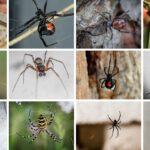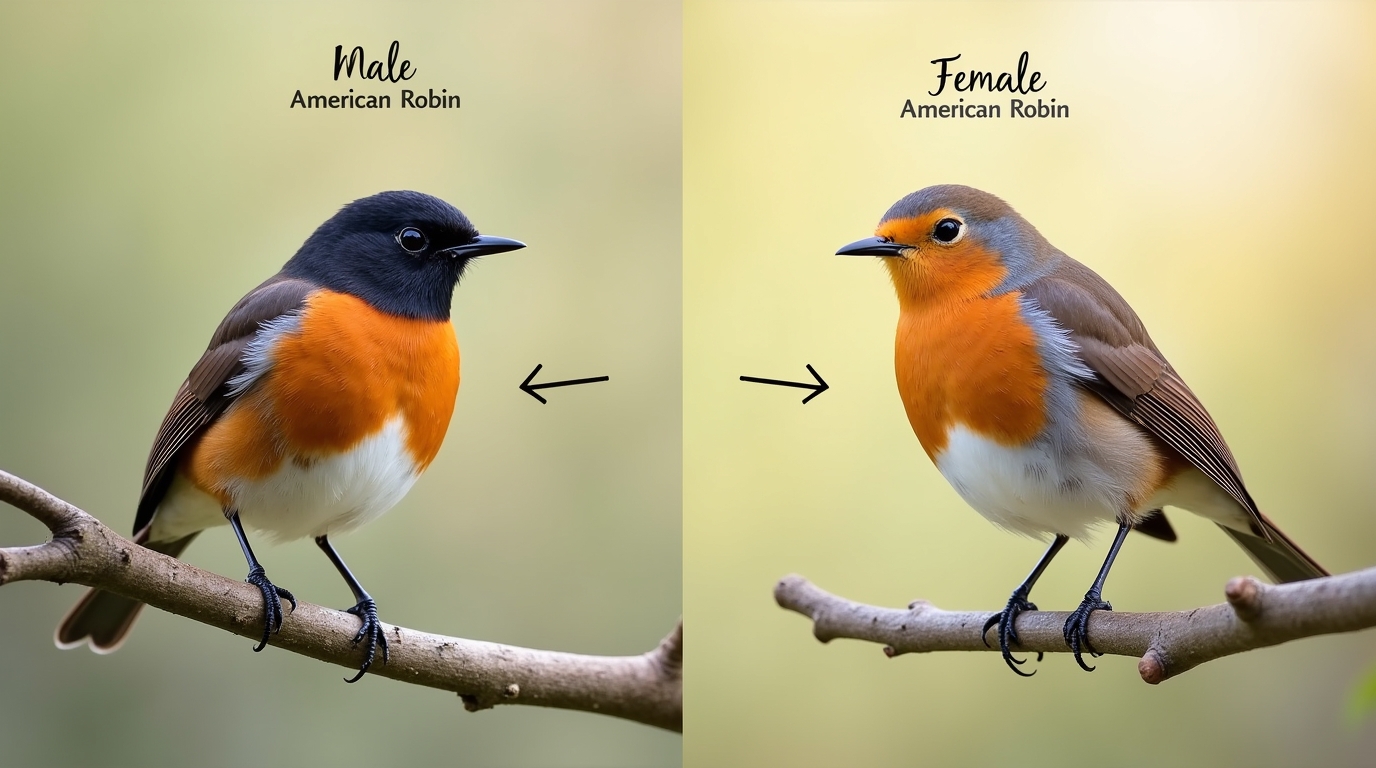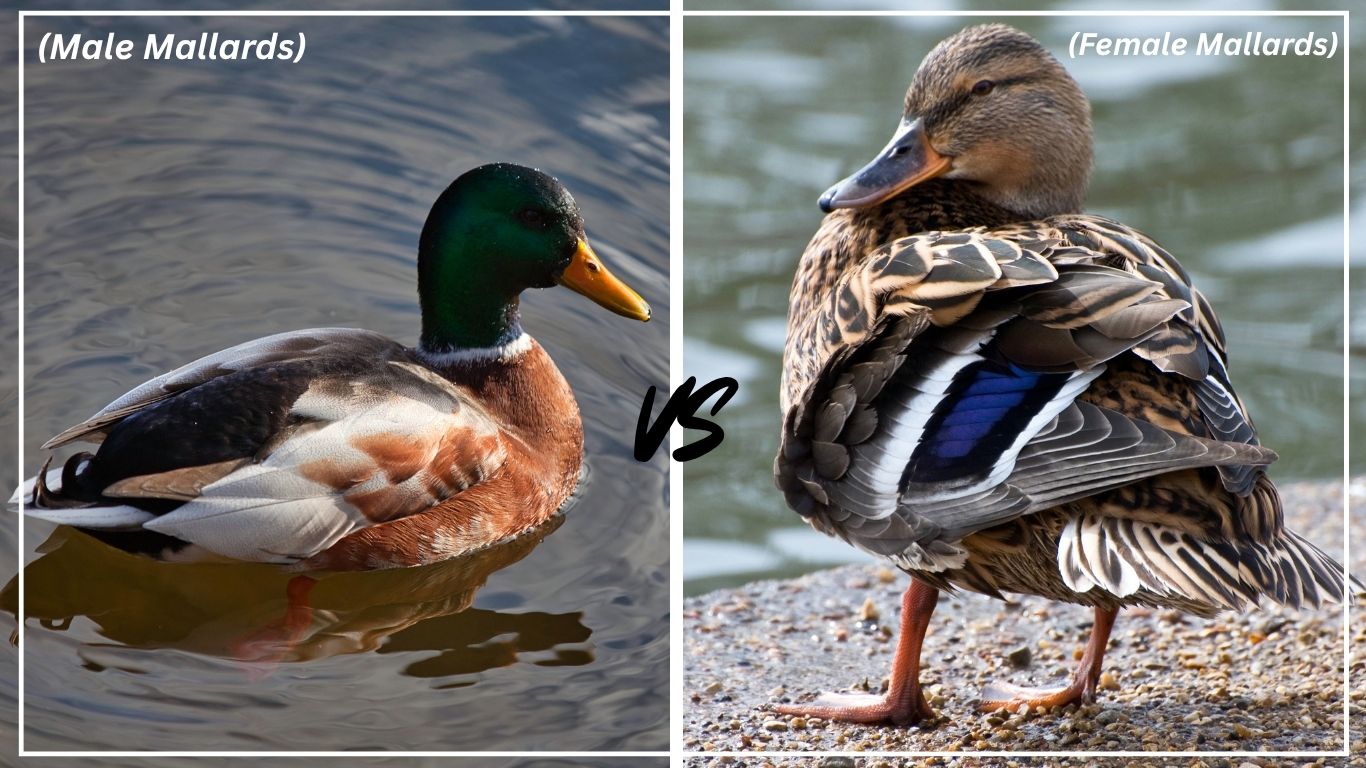Cardinals are some of the most eye-catching birds in the Americas, known for their vivid colors, distinctive crests, and strong beaks. While many people are familiar with the Northern Cardinal, there are several other unique types found across North and South America. From the desert-loving Pyrrhuloxia to the tropical Red-capped Cardinal, each species has its own charm. This guide highlights 11 types of cardinal birds with key features and habitats.
1. Northern Cardinal
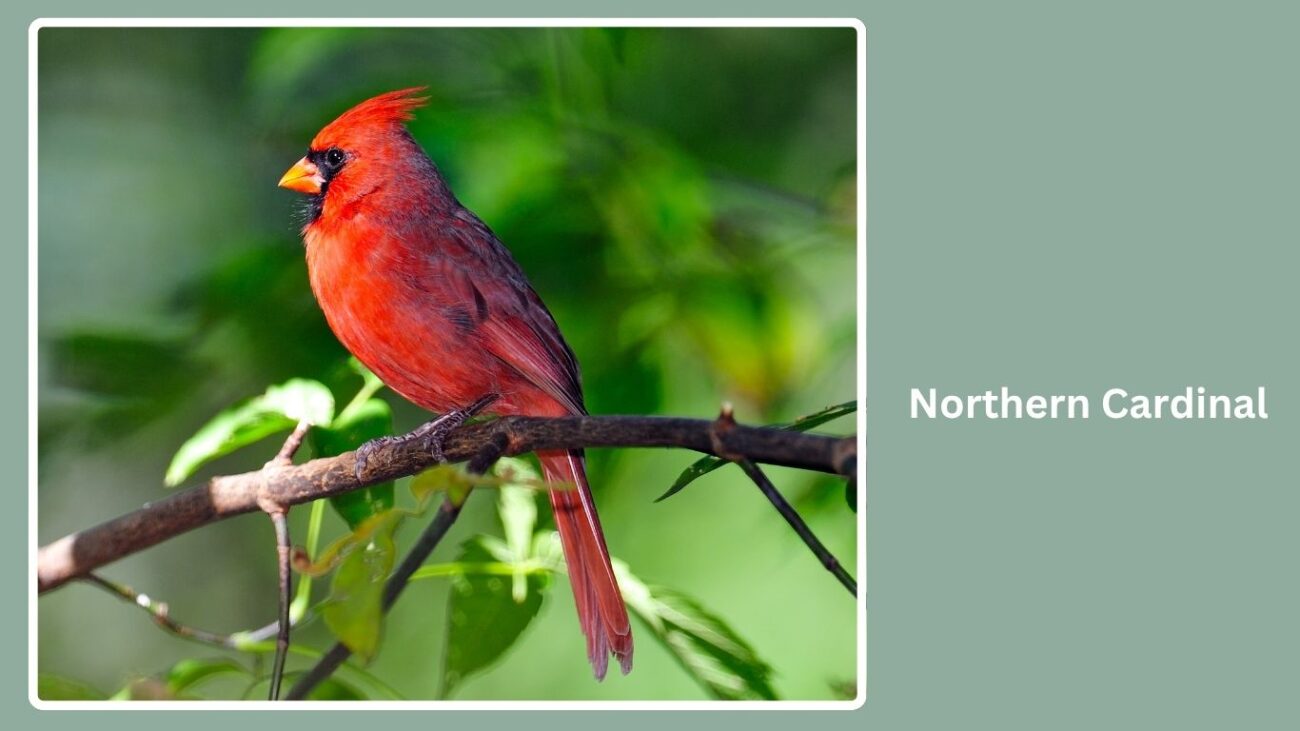
The Northern Cardinal is one of the most iconic and recognizable songbirds in North America. Known for its bright red plumage and melodic whistles, this bird is a year-round favorite in backyards and woodlands.
Identification and Color Features
- Male: Vivid red all over with a sharply defined black mask around the face and throat.
- Female: Soft brown with subtle red highlights on the wings, crest, and tail.
- Shared Traits: Both sexes have a prominent crest on the head, a thick, conical orange beak, and long tails.
Habitat and Geographic Range
Northern Cardinals are found widely across the eastern and central United States, parts of Mexico, and into Central America. They favor habitats with dense shrubs, forest edges, suburban gardens, parks, and thickets. These birds are non-migratory and remain in their territories throughout the year.
Diet and Feeding Habits
They primarily eat seeds, berries, fruits, and insects. Their strong beaks allow them to crack sunflower seeds and other hard-shelled foods. In backyard feeders, they are especially attracted to black-oil sunflower seeds, safflower, and suet.
Mating and Nesting Behavior
Northern Cardinals are monogamous during the breeding season. Males sing to attract females and to warn off other males. Once paired, the female builds a cup-shaped nest in dense shrubs or low trees, laying 2–5 eggs per clutch. The male often feeds the female during incubation and helps care for the chicks.
2. Vermilion Cardinal

The Vermilion Cardinal is a striking bird native to parts of northern South America. With its blazing red color and dramatic crest, it closely resembles the Northern Cardinal but is found in much drier, tropical environments.
Identification and Color Features
- Male: Brilliant crimson-red body with a long, feathery crest and dark face mask.
- Female: Pale brownish-orange with a warm, peach-toned face and a shorter crest.
- Both: Thick orange-red beak, large eyes, and medium-length tail feathers.
Habitat and Geographic Range
This species is found primarily in Venezuela and Colombia, especially in arid scrublands and dry forest edges. Unlike many forest birds, they prefer dry, thorny vegetation and open woodlands.
Diet and Feeding Habits
Vermilion Cardinals eat seeds, fruits, and insects. They forage close to the ground or in low shrubs and may be spotted hopping through underbrush or feeding on fallen berries.
Mating and Nesting Behavior
Pairs form strong bonds and are often seen together. The female constructs a nest in shrubs or low trees using grasses, twigs, and rootlets. She lays 2–4 eggs per clutch and incubates them while the male stands guard or forages nearby.
3. Red-crested Cardinal
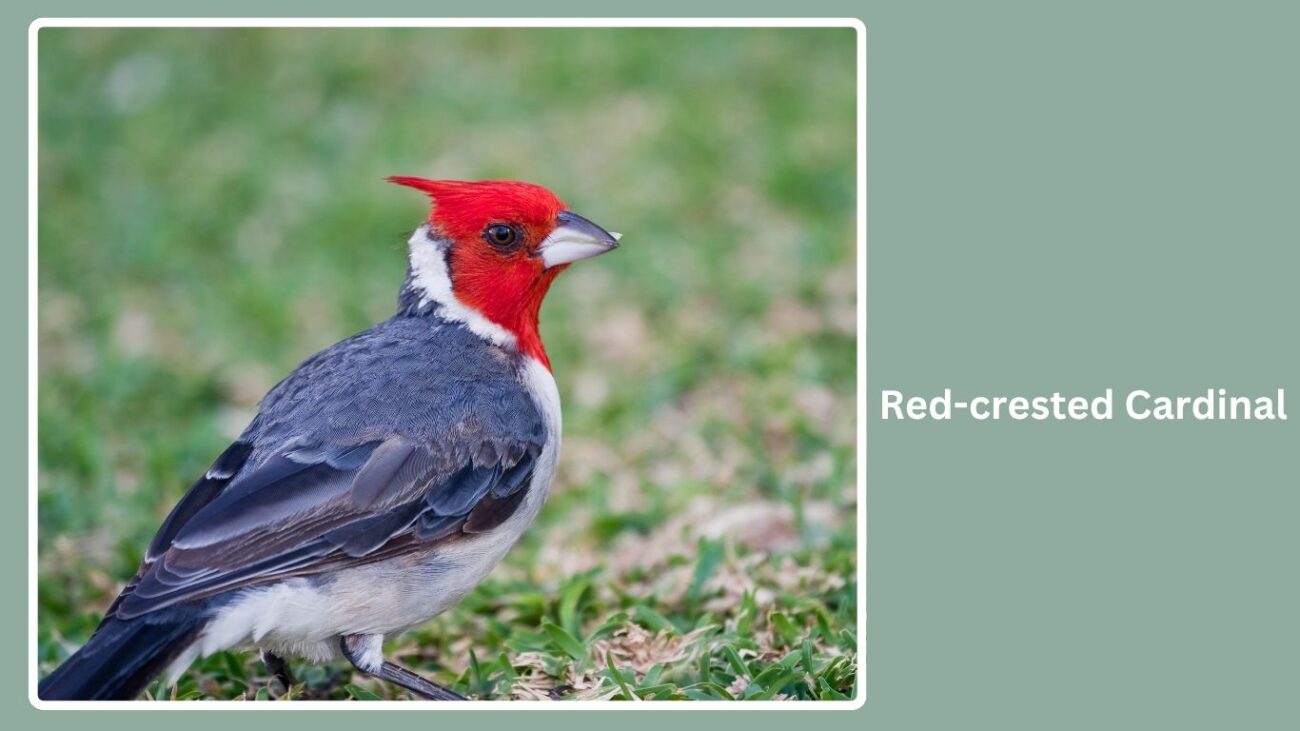
The Red-crested Cardinal is not a true cardinal but is often grouped with them due to its vibrant red crest and similar shape. Originally from South America, it has become a familiar sight in places like Hawaii, where it was introduced.
Identification and Color Features
- Adult: Bright red head and crest, white throat and underparts, and soft gray wings and back.
- Juvenile: Duller overall with a brownish crest and mottled plumage.
- Both: Distinct red crest stands upright; thick, pale beak adds to their characteristic look.
Habitat and Geographic Range
Native to Argentina, Bolivia, Brazil, and Paraguay, Red-crested Cardinals thrive in savannas, open forests, gardens, and urban areas. In Hawaii, they’re commonly seen in parks and neighborhoods.
Diet and Feeding Habits
Their diet includes seeds, berries, flower buds, and small insects. These birds are opportunistic and will visit bird feeders, especially where grains and fruit are available.
Mating and Nesting Behavior
They typically nest in shrubs, trees, or even ornamental plants near human settlements. The nest is a neat cup made of twigs and grasses, where the female lays 2–3 eggs. Both parents may help feed the chicks once hatched.
4. Yellow-billed Cardinal
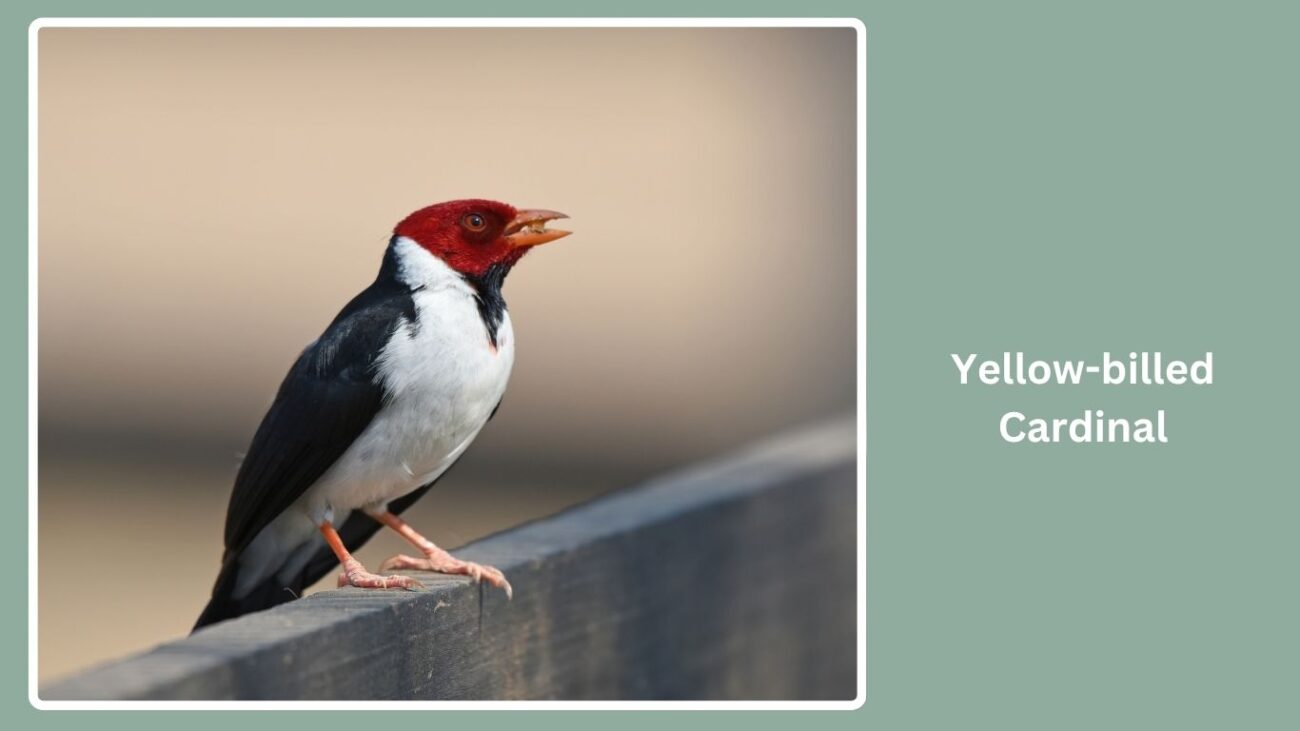
The Yellow-billed Cardinal is a beautifully marked bird with a vibrant red face and a striking yellow bill. Though not a true cardinal, it belongs to the same group and shares several visual traits with other cardinal species.
Identification and Color Features
- Adult: Bright red head, throat, and upper chest, contrasting with a white belly and grayish-black back and wings.
- Bill: Distinct yellow, which stands out against the red face.
- Crest: Lacks the raised crest seen in Northern Cardinals.
Habitat and Geographic Range
This bird is native to South America, especially Brazil, Paraguay, and northern Argentina. It prefers riverbanks, savannas, and wetlands but also adapts well to agricultural and urban areas.
Diet and Feeding Habits
The Yellow-billed Cardinal feeds on seeds, small fruits, and insects. It often forages in pairs or small flocks and may visit human dwellings where food scraps are available.
Mating and Nesting Behavior
They build their nests low in vegetation, especially near water. The nest is constructed from grasses and plant fibers. Females lay 2–3 eggs, and both parents share feeding duties once the chicks hatch.
5. Masked Cardinal
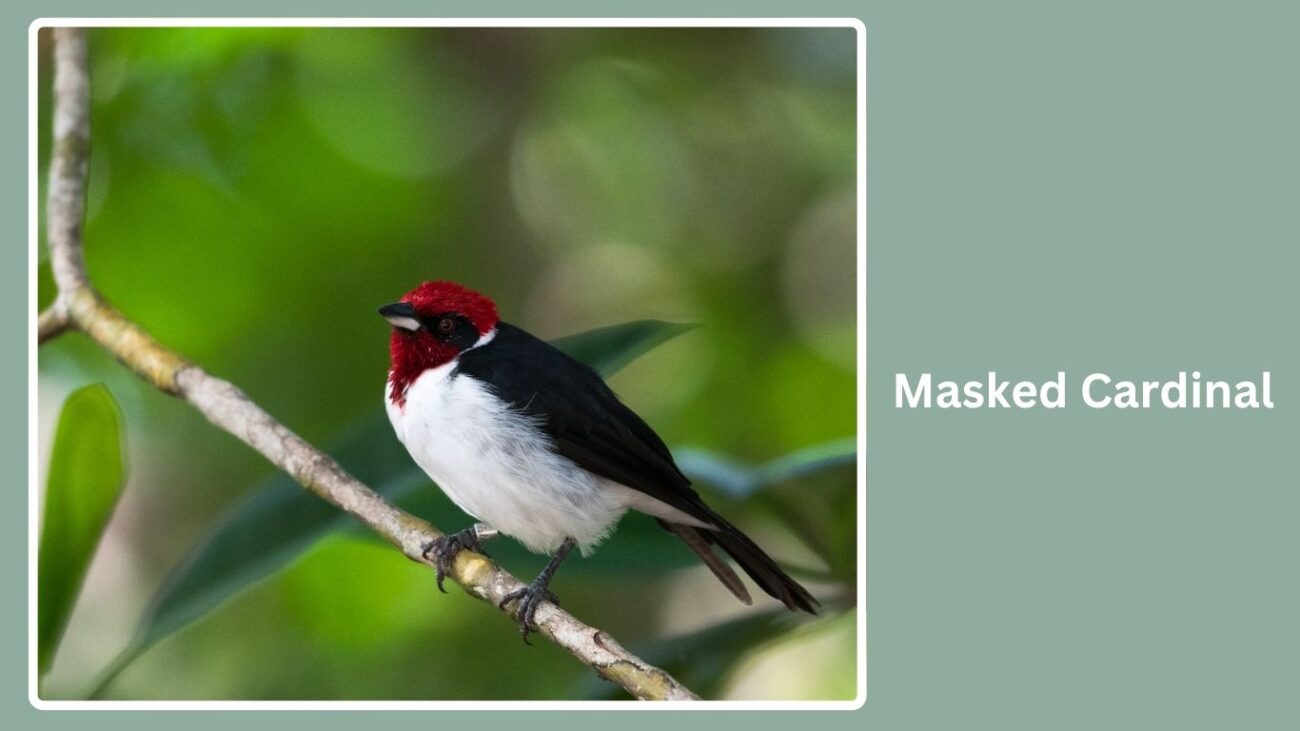
The Masked Cardinal is another South American beauty, known for its unique facial markings and bold red plumage. It’s a close relative of the Red-capped Cardinal but features a darker face.
Identification and Color Features
- Adult: Red head and chest, black face mask extending from the eyes through the throat, and white underparts. The back is grayish.
- Bill: Pale gray or whitish.
- Eyes: Bright and expressive, often with a reddish hue.
Habitat and Geographic Range
This species is primarily found in northern South America, including Venezuela, Colombia, and parts of Brazil. It inhabits riverside forests, swampy woodlands, and dense thickets near water.
Diet and Feeding Habits
Masked Cardinals consume a variety of seeds, fruits, and insects. They’re often seen hopping along low branches or shrubs in search of food, sometimes joining mixed-species feeding flocks.
Mating and Nesting Behavior
They nest in low trees or shrubs, usually close to water. The female lays 2–3 eggs and lines the nest with soft materials. Both parents are attentive caregivers, feeding the chicks until they fledge.
6. Red-capped Cardinal
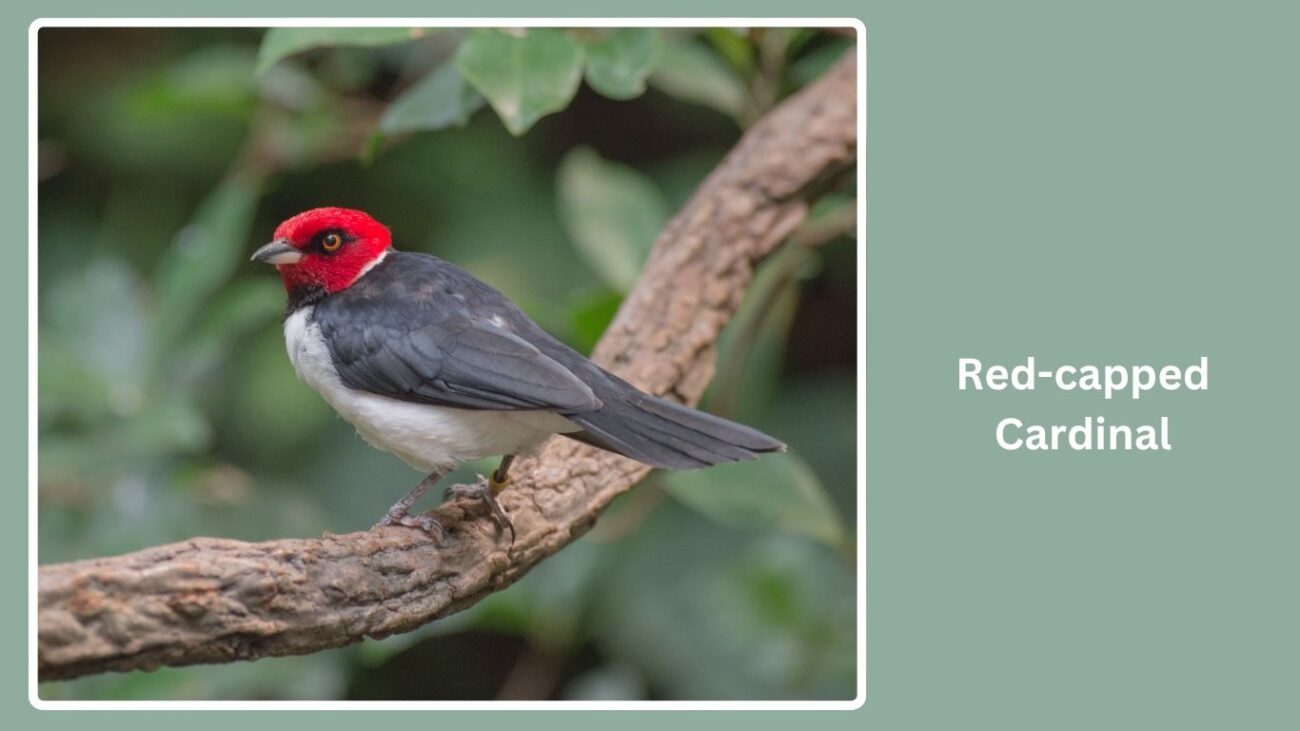
The Red-capped Cardinal is a visually stunning bird with a vivid red head and glossy black wings. Though smaller than many other cardinals, its bold coloration makes it stand out in its native habitats.
Identification and Color Features
- Adult: Bright red head and throat, contrasting with a white belly and dark black back and wings.
- Crest: Lacks a raised crest but has a smooth, rounded red crown.
- Beak: Pale yellowish-white and sharply conical.
Habitat and Geographic Range
Native to tropical regions of South America, particularly Venezuela, Colombia, and the Amazon Basin. It thrives in humid lowland forests, mangroves, and along riversides.
Diet and Feeding Habits
Feeds on seeds, fruits, and small insects. Often forages in low vegetation near water, hopping along branches and sometimes feeding in small groups.
Mating and Nesting Behavior
The Red-capped Cardinal builds small cup nests in bushes or overhanging branches near water. Females typically lay 2–3 eggs, and both parents share the responsibilities of incubation and feeding the young.
7. Black-faced Cardinal

The Black-faced Cardinal is less commonly seen but is easily identified by its bold red plumage paired with a deep black facial mask, giving it a dramatic appearance.
Identification and Color Features
- Adult: Red head and body, white chest and belly, and a distinctive black mask covering the face and throat.
- Wings and Back: Dark gray to black, adding to the contrast.
- Beak: Pale yellow, thick and pointed.
Habitat and Geographic Range
This species is found in northern South America, including areas of Brazil, Suriname, and French Guiana. It lives in forested wetlands, swamps, and densely vegetated river edges.
Diet and Feeding Habits
Feeds primarily on seeds and small fruits but will also eat insects when available. Forages near the ground or in low shrubs, often in pairs.
Mating and Nesting Behavior
Prefers dense, low vegetation for nesting. Builds a compact nest using grass and fibers, and lays 2–4 eggs. Both parents participate in raising the chicks.
8. Crimson-fronted Cardinal
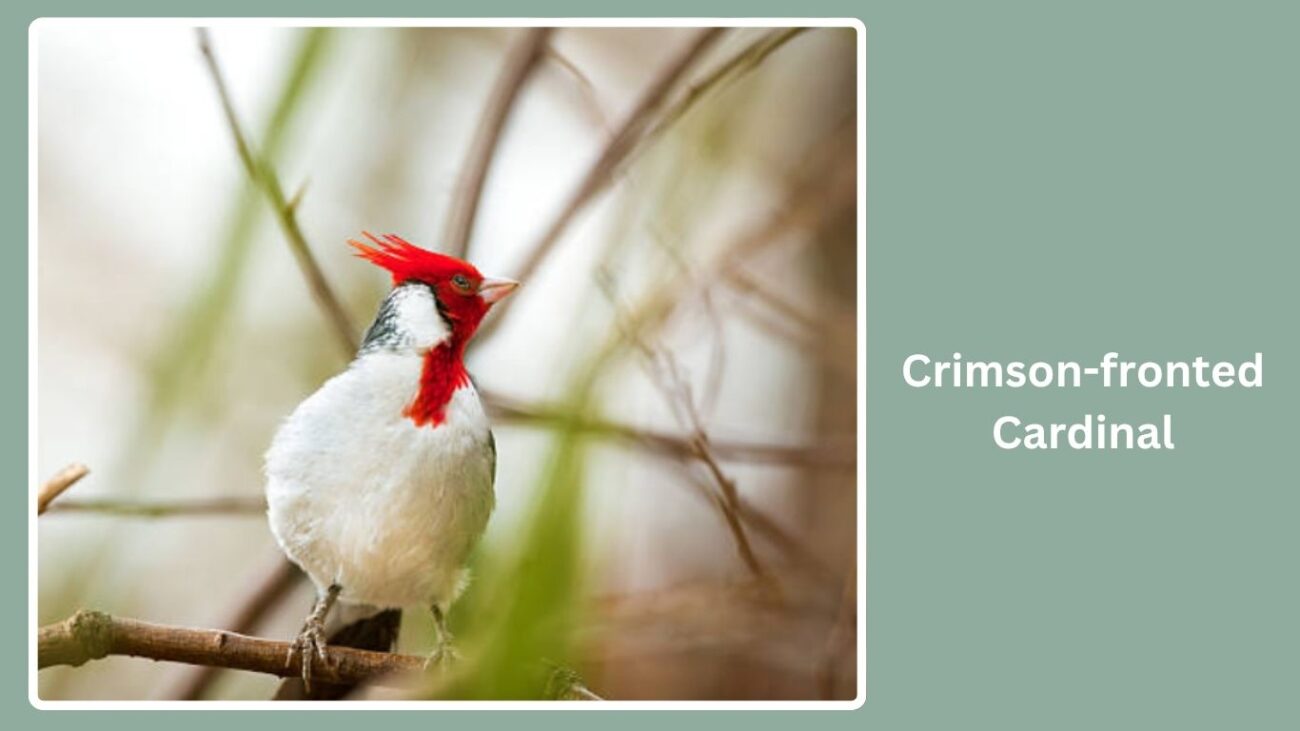
The Crimson-fronted Cardinal is a rare and lesser-known member of the cardinal group, recognized by its uniquely colored forehead and refined markings.
Identification and Color Features
- Adult: Red forehead and face, blending into a white lower face and underparts. The back, wings, and tail are grayish-black.
- Forehead: The defining crimson patch gives the bird its name.
- Beak: Pale and conical, well-suited for seed eating.
Habitat and Geographic Range
Native to parts of South America, particularly in tropical lowland areas. It prefers forest borders, secondary growth, and riverine environments where it can find dense cover.
Diet and Feeding Habits
This cardinal feeds on a mix of small seeds, berries, and insects. It typically forages low to the ground, often staying hidden among dense foliage.
Mating and Nesting Behavior
Not much is widely documented due to its rarity, but it is believed to nest in shrubs or low branches, laying 2–3 eggs in a cup-shaped nest lined with soft plant fibers.
9. Grey-headed Cardinal
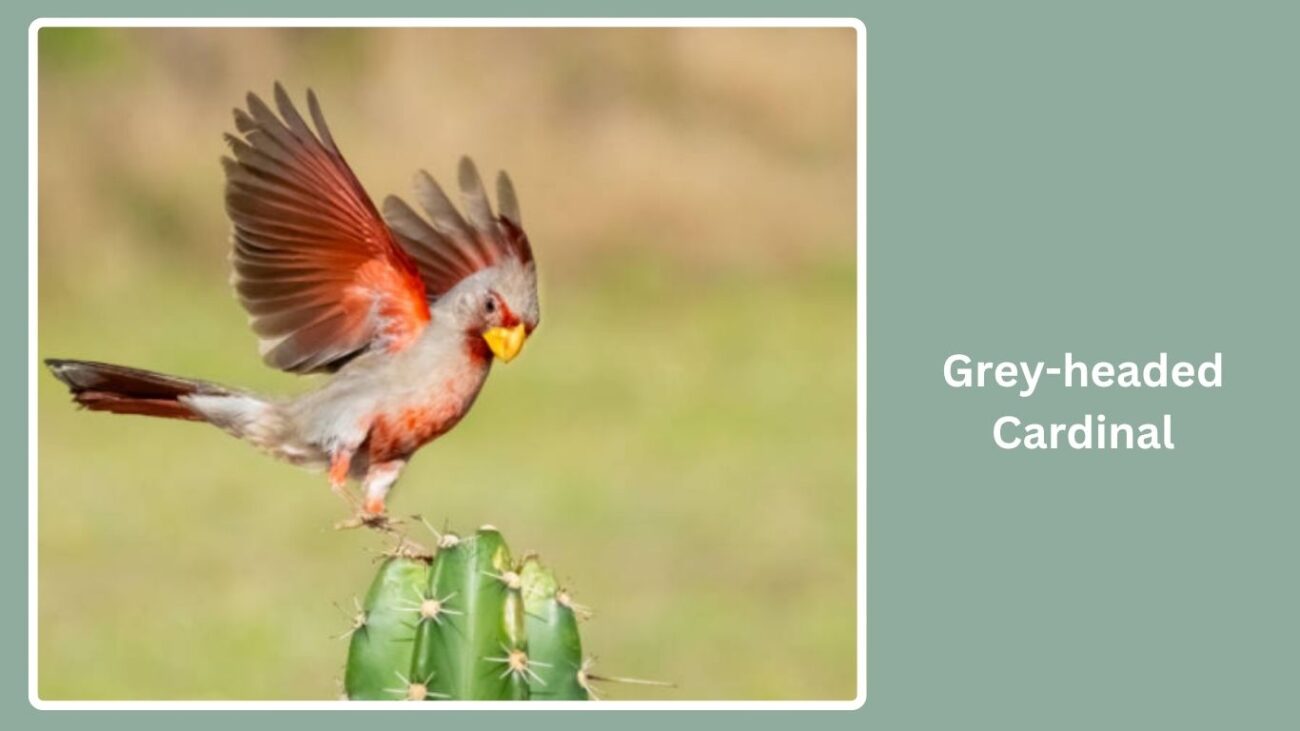
The Grey-headed Cardinal stands out from its relatives by replacing the typical red head with a cool, slate-gray tone, making it one of the more unusual cardinals in appearance.
Identification and Color Features
- Adult: Gray head and upper chest, white belly, and dark back and wings. The bill is yellowish, and the overall look is more subdued than bright red species.
- Shape: Shares the cardinal’s stout build and medium-length tail.
- Crest: Absent or very minimal.
Habitat and Geographic Range
Found in parts of South America, especially in Bolivia, Paraguay, and Argentina. It inhabits open woodland, gallery forests, and areas near water.
Diet and Feeding Habits
Feeds on seeds, grains, and the occasional insect. Foraging occurs mostly on the ground or low bushes, often alone or in pairs.
Mating and Nesting Behavior
They nest in low shrubs or small trees, creating a shallow cup nest. The female lays 2–4 eggs, and both parents are involved in chick care and feeding.
10. Pyrrhuloxia (Desert Cardinal)
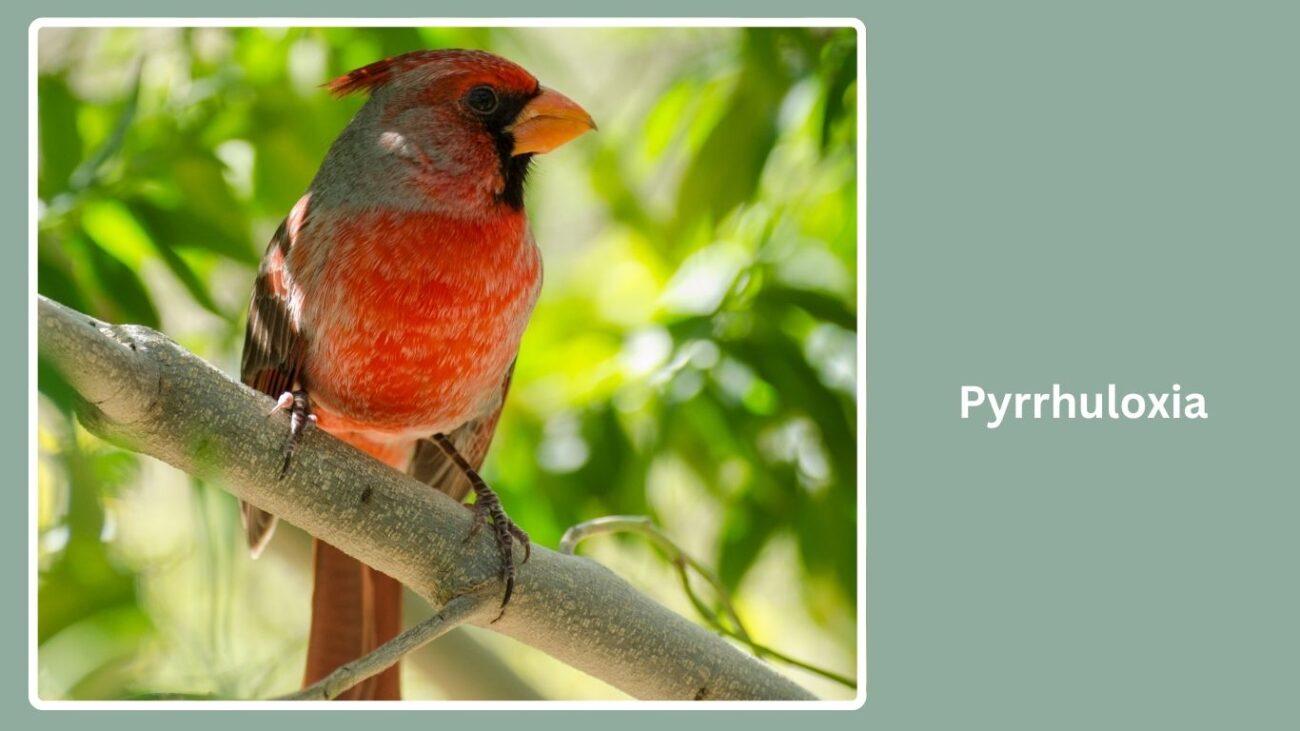
The Pyrrhuloxia, often called the Desert Cardinal, is a close relative of the Northern Cardinal. It thrives in arid desert landscapes and is adapted to hot, dry climates.
Identification and Color Features
- Male: Gray body with bold red accents on the face, crest, wings, and tail.
- Female: Paler gray with more subtle red markings.
- Beak: Distinctively curved and yellow, resembling a parrot’s beak.
- Crest: Prominent, like the Northern Cardinal.
Habitat and Geographic Range
Native to the southwestern United States and northern Mexico, Pyrrhuloxias prefer desert scrub, mesquite thickets, and cactus-filled areas. They are commonly found in Texas, Arizona, and New Mexico.
Diet and Feeding Habits
Their diet consists mainly of seeds, grains, and some insects. They’re well adapted to foraging in dry areas and often visit feeders offering millet or cracked corn.
Mating and Nesting Behavior
They breed in spring and early summer. The female builds a nest in a shrub or small tree, laying 2–4 eggs. Males help defend the territory while the female incubates the eggs.
11. Cardinal Grosbeak
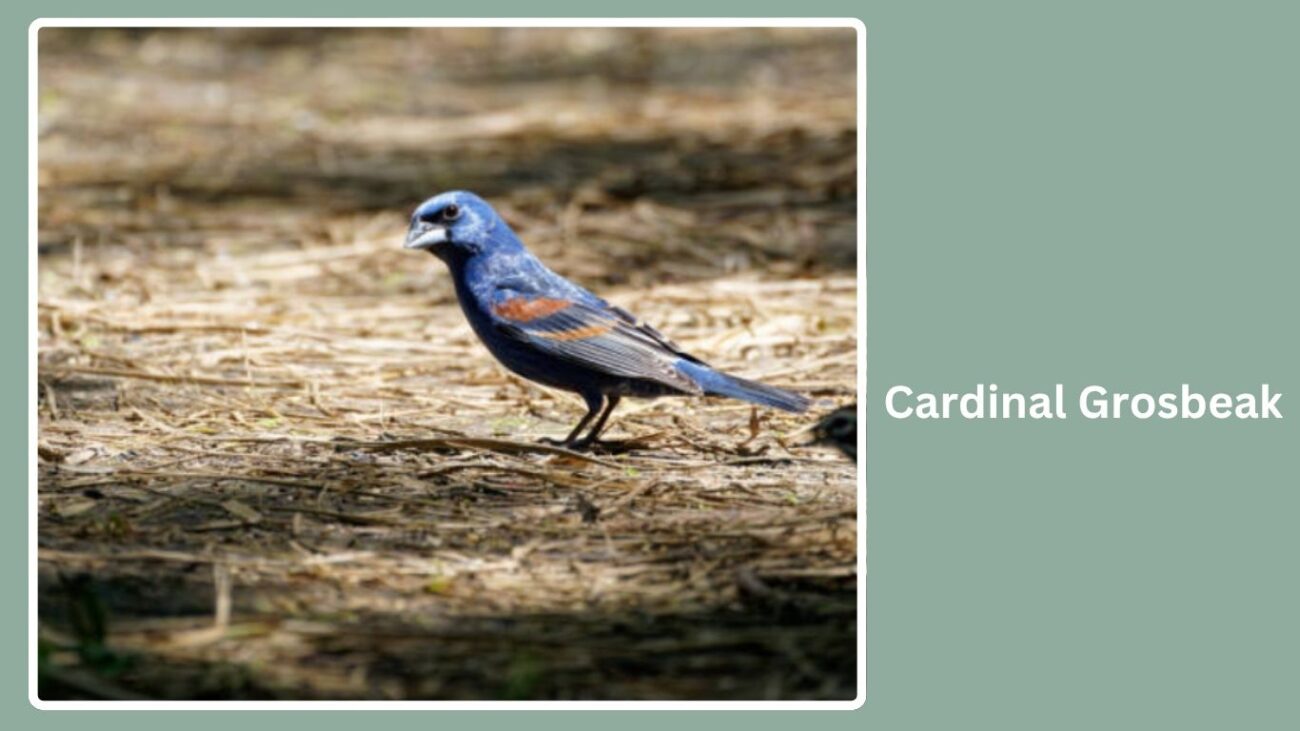
The term “Cardinal Grosbeak” is an older or alternative name sometimes used for the Northern Cardinal, especially in historical texts. While not a separate species, it reflects the bird’s thick, seed-cracking beak and its placement among grosbeak-type birds.
Identification and Color Features
- Same as Northern Cardinal: Bright red (male), brownish-red (female), with a black mask and large orange beak.
- Not a separate visual variant, but the name emphasizes its beak structure.
Habitat and Geographic Range
Same range as the Northern Cardinal — widespread across the eastern and central U.S., Mexico, and parts of Central America.
Diet and Feeding Habits
Feeds on seeds, berries, and insects. The strong, cone-shaped beak is perfect for cracking tough seeds and nuts.
Mating and Nesting Behavior
Same as Northern Cardinal. They are territorial, form strong pair bonds, and raise multiple broods each breeding season.
Comparison Table
| No. | Bird Name | Head Color | Crest | Beak Color | Native Region | Unique Feature |
| 1 | Northern Cardinal | Bright Red (M) | Yes | Orange | North & Central America | Most recognized cardinal in North America |
| 2 | Vermilion Cardinal | Crimson Red (M) | Yes | Orange-Red | Venezuela, Colombia | Lives in dry, scrubby habitats |
| 3 | Red-crested Cardinal | Red | Yes | Pale Yellow | South America, Hawaii (introduced) | White body with red crest |
| 4 | Yellow-billed Cardinal | Red | No | Yellow | Brazil, Paraguay, Argentina | Yellow beak with a red face |
| 5 | Masked Cardinal | Red + Black Mask | No | Grayish | Northern South America | Black mask across face and throat |
| 6 | Red-capped Cardinal | Bright Red Cap | No | Pale | Venezuela, Colombia, Amazon Basin | Smooth red crown, not crested |
| 7 | Black-faced Cardinal | Red + Black Face | No | Yellow | Brazil, French Guiana, Suriname | Bold black mask with red plumage |
| 8 | Crimson-fronted Cardinal | Crimson Forehead | No | Pale | Tropical South America | Red only on forehead |
| 9 | Grey-headed Cardinal | Gray | No | Yellowish | Bolivia, Paraguay, Argentina | Gray head instead of red |
| 10 | Pyrrhuloxia (Desert Cardinal) | Gray + Red | Yes | Yellow | SW United States, N. Mexico | Curved yellow beak, desert adaptation |
| 11 | Cardinal Grosbeak | Same as N. Cardinal | Yes | Orange | Same as Northern Cardinal | Old term, emphasizes large beak |
Summary
There are 11 remarkable types of cardinal birds, each with its own appearance, range, and behavior. While the Northern Cardinal is the most recognized, others like the Vermilion, Red-crested, and Masked Cardinals stand out with striking colors and unique traits. Some prefer woodlands, while others thrive in deserts or wetlands. This comparison helps bird lovers appreciate the diversity within the cardinal family and better understand where these beautiful birds live and how they differ.




